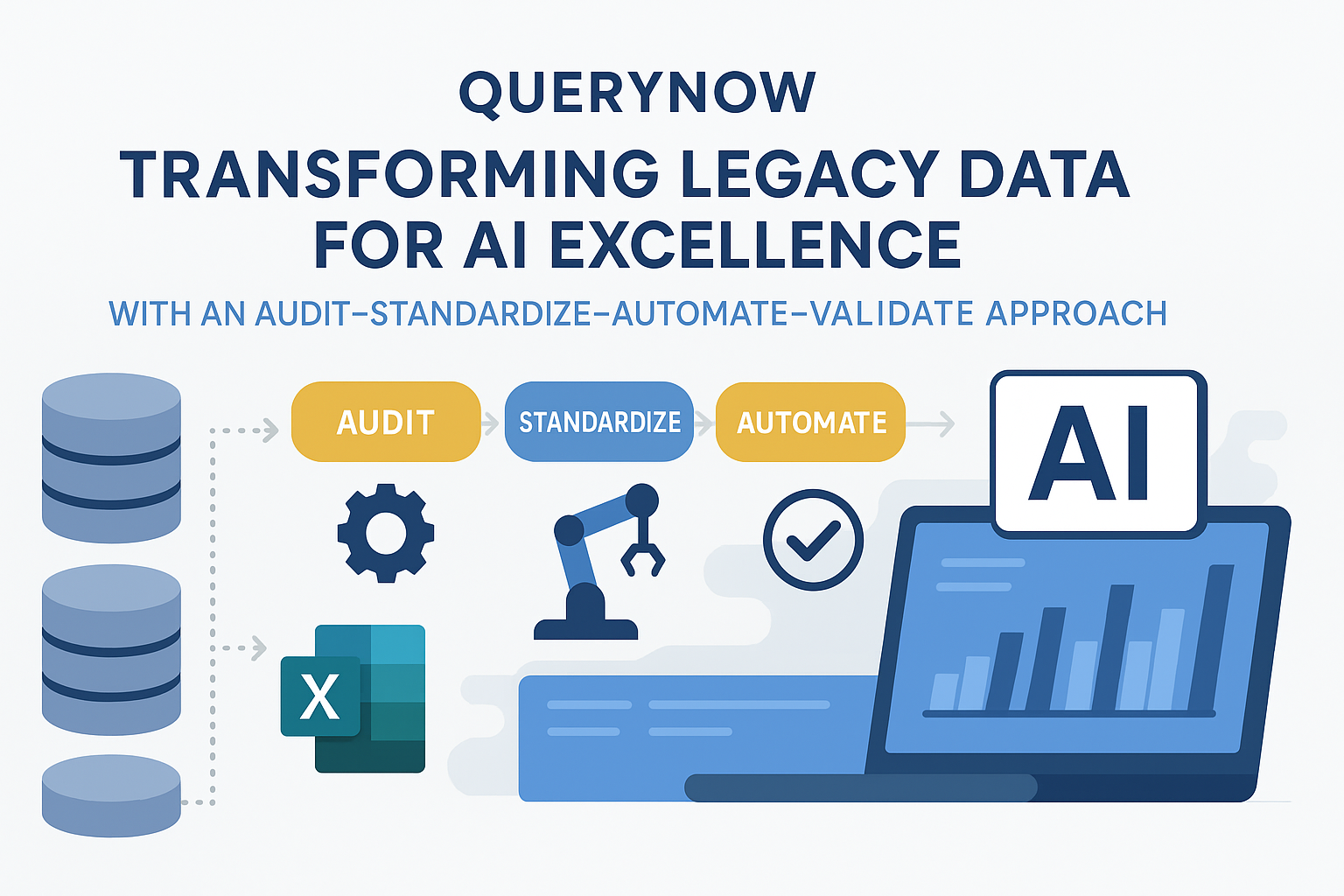
The AI Data Quality Crisis
Organizations invest millions in AI talent, infrastructure, and tools, then watch initiatives fail because of data quality. The problem is not the AI models or data science teams—it is the data itself.
Legacy systems accumulate data quality problems over decades: inconsistent formats, duplicate records, missing values, conflicting definitions, undocumented transformations, and business rules buried in application code. This data worked fine for traditional applications designed to handle its quirks. It fails catastrophically with AI.
Data scientists spend 80% of their time cleaning data instead of building models. AI models trained on poor data deliver unreliable results. Executives lose confidence in AI initiatives. The entire AI strategy stalls.
Why Legacy Data Breaks AI Models
Traditional applications tolerate data quality issues that devastate AI:
Inconsistent Formats: Date stored as "01/15/2024" in one system, "2024-01-15" in another, and "Jan 15, 2024" in a third. Human users adapt easily. AI models fail or produce nonsense.
Missing Values: Required fields null or default values like "N/A", "Unknown", "TBD", or "999". Business applications handle these through special case logic. AI models interpret them as legitimate values producing incorrect predictions.
Duplicate Records: Same entity represented multiple times with slight variations in name, address, or identifiers. Applications manage through manual reconciliation. AI models treat duplicates as distinct entities skewing analysis.
Semantic Inconsistency: "Revenue" means gross revenue in one system, net revenue in another, and recognized revenue in a third. Humans understand context. AI models cannot distinguish leading to meaningless aggregations.
Data Drift: Business rules and data definitions change over time but historical data is not updated. Models trained on data spanning these changes produce unreliable results.
Hidden Dependencies: Critical business logic embedded in application code rather than data. AI has no visibility to these rules producing results that violate unstated business constraints.
The Audit-Standardize-Automate-Validate Framework
QueryNow developed a systematic approach transforming problematic legacy data into AI-ready assets. The framework addresses root causes of data quality issues rather than applying superficial fixes.
Phase 1: Comprehensive Data Audit
Before fixing data, understand what is wrong. Our audit process discovers data quality issues that block AI success:
Profiling Analysis: Automated profiling of all data sources identifying data types, value distributions, null percentages, uniqueness, and patterns. Statistical analysis reveals anomalies and inconsistencies.
Schema Documentation: Reverse-engineering of data structures including tables, columns, relationships, and constraints. Many legacy systems lack current documentation.
Business Rule Discovery: Analysis of application code extracting embedded business logic. These hidden rules are critical for data interpretation.
Lineage Mapping: Tracing data flow from source systems through transformations to target systems. Understanding lineage is essential for quality issue root cause analysis.
Quality Metrics: Quantifying completeness, accuracy, consistency, timeliness, and validity. Metrics provide baseline for measuring improvement.
Impact Assessment: Evaluating which quality issues actually matter for planned AI use cases. Not all data problems require fixing—focus on those blocking AI value.
Phase 2: Data Standardization
Transform inconsistent data into clean, consistent formats AI can consume:
Format Normalization: Converting all dates, addresses, phone numbers, and other structured data to consistent formats. Eliminates format-related AI failures.
Entity Resolution: Identifying and merging duplicate records representing same entities. Creates single source of truth for each business entity.
Reference Data Management: Establishing authoritative reference data for products, customers, locations, and other master data. Ensures consistency across systems.
Semantic Harmonization: Standardizing definitions and calculations across systems. "Revenue" means the same thing everywhere after harmonization.
Missing Value Treatment: Intelligent handling of missing data through imputation where appropriate or explicit null handling where imputation would introduce bias.
Outlier Management: Identifying and appropriately handling outliers and anomalies. Distinguish legitimate edge cases from data errors.
Phase 3: Automation Pipeline
Manual data cleaning is not sustainable. Automation ensures ongoing data quality:
ETL Pipeline Modernization: Rebuilding data integration pipelines incorporating quality checks and transformations. Data enters clean, not cleaned later.
Real-Time Validation: Implementing validation rules at data entry points preventing bad data from entering systems. Prevention beats correction.
Continuous Profiling: Automated monitoring of data quality metrics alerting on degradation. Early detection prevents quality issues from accumulating.
Transformation Standardization: Codifying data transformations in reusable components rather than scattered across applications. Ensures consistency and maintainability.
Metadata Management: Automated capture and maintenance of data lineage, business rules, and quality metrics. Documentation stays current automatically.
Phase 4: Continuous Validation
Data quality requires ongoing attention. Validation ensures quality is maintained:
Quality Dashboards: Real-time visibility into data quality metrics across all sources. Business and technical stakeholders monitor quality trends.
Automated Testing: Continuous validation of data quality rules, transformations, and AI model inputs. Prevents quality regressions.
Data Quality SLAs: Establishing measurable quality standards with accountability for maintenance. Quality becomes operational requirement, not project activity.
Feedback Loops: Monitoring AI model performance and tracing issues to data quality problems. Continuous improvement based on actual AI usage.
Governance Framework: Policies and processes ensuring data quality responsibility is assigned, quality rules are maintained, and issues are resolved systematically.
Real-World Results
Manufacturing: Predictive Maintenance AI
A manufacturer wanted to predict equipment failures using sensor data from production lines. Initial attempts failed—models had 40% false positive rates making them useless.
Data audit revealed sensor timestamps were unreliable, equipment IDs were inconsistent across systems, maintenance records had 30% missing data, and sensor calibration history was not recorded.
After standardization:
- Timestamps synchronized to common reference
- Equipment master data established with consistent IDs
- Missing maintenance records reconstructed from work orders
- Sensor calibration data integrated from maintenance systems
Model accuracy improved from 60% to 94%. Predictive maintenance now prevents 85% of unplanned downtime delivering $8M annual savings.
Healthcare: Patient Risk Prediction
A healthcare system developed AI predicting patient readmission risk. Models performed poorly—too many false alarms to be clinically useful.
Audit found patient data spread across six systems with no consistent patient ID, medication names varied between generic and brand names, diagnosis codes used different standards (ICD-9 vs ICD-10), and lab results used inconsistent units.
Standardization created unified patient view, normalized medication and diagnosis codes, and converted all lab results to consistent units.
Model performance improved enabling clinical deployment. Readmissions reduced by 23% through early intervention for high-risk patients.
Financial Services: Fraud Detection
A bank's fraud detection AI had high false positive rates causing customer friction and support costs.
Data quality analysis revealed transaction timestamps were in local time zones causing incorrect temporal analysis, merchant categories were inconsistently coded, customer demographic data was outdated, and device fingerprinting data had gaps.
After data transformation, false positives dropped 60% while maintaining fraud detection rates. Customer satisfaction improved and support costs decreased significantly.
Technology Platform
Our framework leverages Microsoft Azure data platform:
Azure Data Factory: Orchestration of data pipelines with built-in data quality monitoring and transformation capabilities.
Azure Synapse Analytics: Unified analytics platform for data profiling, quality analysis, and transformation at scale.
Azure Purview: Data governance and metadata management providing lineage visibility and quality tracking.
Azure Databricks: Advanced data transformation and quality automation using Apache Spark.
Power BI: Data quality dashboards and monitoring for business and technical stakeholders.
This integrated platform provides end-to-end data quality capabilities without requiring custom development or point solutions.
Implementation Approach
Phase 1: Discovery (2-3 Weeks): Data audit, quality assessment, and AI use case analysis. Deliverable is comprehensive data quality report with improvement roadmap.
Phase 2: Quick Wins (4-6 Weeks): Address high-impact quality issues blocking immediate AI use cases. Build confidence through rapid value delivery.
Phase 3: Systematic Remediation (8-12 Weeks): Implement comprehensive standardization and automation. Build sustainable data quality capability.
Phase 4: Operationalization (Ongoing): Continuous monitoring, validation, and improvement. Data quality becomes operational discipline.
Common Pitfalls to Avoid
Boiling the Ocean: Trying to perfect all data before starting AI. Focus on data needed for specific high-value use cases first.
Manual Fixes: Cleaning data manually without automation. Quality degrades as soon as manual effort stops.
Technology-First: Implementing data quality tools without understanding business rules and AI requirements. Tools enable solutions but are not the solution.
Ignoring Source Systems: Cleaning data downstream while leaving source systems broken. Fix root causes in source systems when possible.
Insufficient Governance: Treating data quality as one-time project rather than ongoing discipline. Quality requires sustained organizational commitment.
The Competitive Advantage of Clean Data
Organizations with high-quality data achieve AI success rates 3-5x higher than those with poor data. Clean data enables faster model development, more reliable predictions, greater business confidence in AI, and ability to deploy more sophisticated AI capabilities.
Conversely, organizations with poor data waste resources on data cleaning, deliver unreliable AI that damages credibility, and miss AI-driven competitive advantages.
Data quality is not a technical problem—it is a business capability that determines AI success or failure.
Ready to prepare your data for AI? Contact QueryNow for a data readiness assessment. We will audit your data quality, identify issues blocking AI success, and implement systematic remediation enabling reliable AI deployment.


